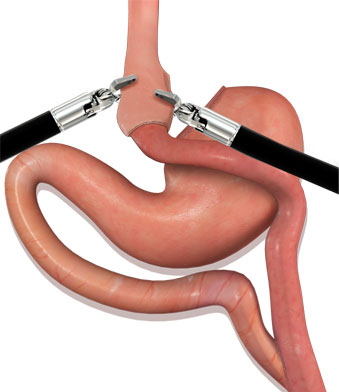Robotic gastric bypass is a type of weight loss/bariatric surgery to treat obesity (excessive weight). In this surgery, the stomach size is reduced to limit your food intake and the small intestine is re-routed to reduce the absorption of food. It is performed using a da Vinci robotic surgical device.

Robotic gastric bypass causes changes in your gut hormones to reduce appetite and help you feel full. It helps minimize the risk of potentially life-threatening health problems due to obesity such as high blood pressure, type 2 diabetes, and gastroesophageal reflux disease.
Indications for Robotic Gastric Bypass
Robotic gastric bypass is considered only after non-surgical approaches like diet and exercise are unsuccessful in reducing excess weight. Not every obese individual requires robotic bypass surgery.
In general, robotic gastric bypass surgery is recommended if you have:
- Body mass index (BMI) of 40 or more (extreme obesity)
- BMI in the range of 35-39.9 (obesity) in addition to serious health problems such as diabetes, hypertension, or severe sleep apnea
In specific cases, your physician can recommend robotic bypass surgery even if you have a BMI in the range of 30-34 but with serious weight-related health problems.
Pre-surgical Instructions for Robotic Gastric Bypass
Before scheduling robotic gastric bypass surgery, your physician completely examines your health condition and lab reports. You will be required to follow specific instructions pertaining to your diet and lifestyle until your surgery. You should continue to take your medications based on your physician’s instructions. You should quit smoking if you do smoke and perform regular exercise.
Robotic Gastric Bypass Procedure
Robotic gastric bypass surgery is performed under general anesthesia.
- You may be placed in supine or reverse Trendelenburg position depending on your surgeon’s discretion.
- A few small incisions are made in your abdomen through which a tiny camera and the surgical instruments are placed in your abdomen.
Robotic gastric bypass surgery consists of two steps:
- Making the stomach smaller: Your surgeon divides the stomach into a smaller upper section (pouch) and a bigger lower section. Food after eating initially reaches the pouch section of the stomach. The pouch section of stomach can hold only a small amount (one ounce) of food.
- Bypassing the stomach: Your surgeon will connect the pouch (upper section of stomach) with the small intestine bypassing the bigger lower section of the stomach which results in decreased absorption.
The da Vinci surgical system has three parts which includes the surgeon’s console, robotic arms, and a video tower. The surgeon sits at the console and controls the movements of the robotic arms which are attached to the video tower. One robotic arm holds the camera and the other two or three arms control the surgical instruments that are placed in your abdomen through ports.
The camera provides a high-definition, 3D magnified view of the inside of your body. The da Vinci System is operated by your bariatric surgeon and the robotic arms connected to it help bend and rotate the surgical instruments with precision.
After the surgery is complete, your surgeon removes the camera and other surgical equipment.
The incisions are closed.
Post-surgical Care for Robotic Gastric Bypass
You will be required to stay in the hospital for 3 to 5 days until you are able to consume food and liquids without vomiting and walk around without pain.
- For the initial 2-3 days, a catheter will be inserted through your nose for draining fluids from your belly, and another catheter into your bladder to pass urine.
- You will not be allowed to eat anything at least for one or two days after surgery. You will have a specific diet plan for the initial 12 weeks after surgery starting with liquids, then soft foods, and finally regular foods.
- You may be required to wear compression leg stockings and take medications to prevent blood clots and pain.
- You will be required to visit your doctor in the first few months after your surgery for a complete medical check-up to monitor your recovery.
Benefits and Advantages of Robotic Gastric Bypass
Robotic gastric bypass is performed through small incisions that minimizes pain and scarring. The other benefits include:
- Precise surgery
- Shorter hospital stay
- Less risk of infection compared to other surgeries
Risk and Complications of Robotic Gastric Bypass
Every surgical procedure carries some amount of risk. Likewise, robotic gastric bypass may also lead to certain risks and complications. These include:
- Anesthesia side effects such as nausea and vomiting
- Leakage and/or constriction at the spot where the pouch and the bowel are reconnected which may lead to bowel obstruction and hernia
- Altered food absorption and/or malnutrition
- Dehydration
- Formation of blood clots
- Ulcer, perforation, or leaks in gastrointestinal tract
- Heart attack or stroke during or after surgery





